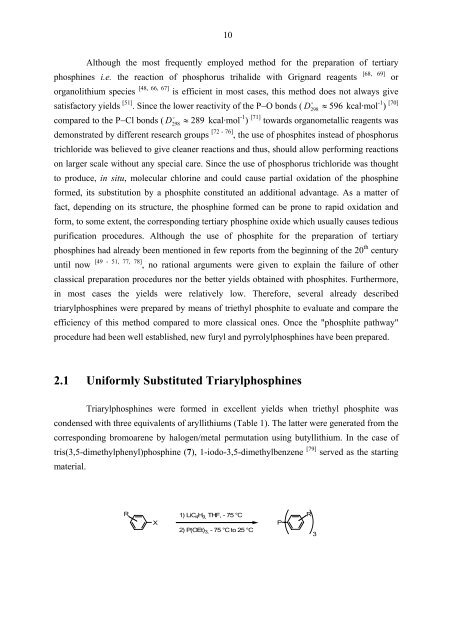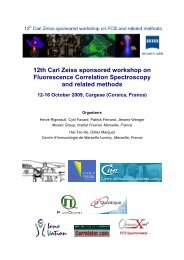My PhD dissertation - Institut Fresnel
My PhD dissertation - Institut Fresnel
My PhD dissertation - Institut Fresnel
You also want an ePaper? Increase the reach of your titles
YUMPU automatically turns print PDFs into web optimized ePapers that Google loves.
10<br />
Although the most frequently employed method for the preparation of tertiary<br />
phosphines i.e. the reaction of phosphorus trihalide with Grignard reagents<br />
[ , ] 68 69 or<br />
organolithium species [48, 66, 67] is efficient in most cases, this method does not always give<br />
satisfactory yields [51] o<br />
-1 [ 70 ]<br />
. Since the lower reactivity of the P−O bonds ( D298<br />
≈ 596 kcal·mol )<br />
o<br />
compared to the P−Cl bonds ( D 289 kcal·mol<br />
298 ≈<br />
demonstrated by different research groups<br />
-1 ) [ ]<br />
71 towards organometallic reagents was<br />
[ - ] 72 76 , the use of phosphites instead of phosphorus<br />
trichloride was believed to give cleaner reactions and thus, should allow performing reactions<br />
on larger scale without any special care. Since the use of phosphorus trichloride was thought<br />
to produce, in situ, molecular chlorine and could cause partial oxidation of the phosphine<br />
formed, its substitution by a phosphite constituted an additional advantage. As a matter of<br />
fact, depending on its structure, the phosphine formed can be prone to rapid oxidation and<br />
form, to some extent, the corresponding tertiary phosphine oxide which usually causes tedious<br />
purification procedures. Although the use of phosphite for the preparation of tertiary<br />
phosphines had already been mentioned in few reports from the beginning of the 20 th century<br />
until now<br />
[49 - 51, , ] 77 78 , no rational arguments were given to explain the failure of other<br />
classical preparation procedures nor the better yields obtained with phosphites. Furthermore,<br />
in most cases the yields were relatively low. Therefore, several already described<br />
triarylphosphines were prepared by means of triethyl phosphite to evaluate and compare the<br />
efficiency of this method compared to more classical ones. Once the "phosphite pathway"<br />
procedure had been well established, new furyl and pyrrolylphosphines have been prepared.<br />
2.1 Uniformly Substituted Triarylphosphines<br />
Triarylphosphines were formed in excellent yields when triethyl phosphite was<br />
condensed with three equivalents of aryllithiums (Table 1). The latter were generated from the<br />
corresponding bromoarene by halogen/metal permutation using butyllithium. In the case of<br />
tris(3,5-dimethylphenyl)phosphine (7), 1-iodo-3,5-dimethylbenzene<br />
material.<br />
R<br />
X<br />
1) LiC 4H 9, THF, - 75 °C<br />
2) P(OEt) 3, - 75 °C to 25 °C<br />
P<br />
[ ] 79 served as the starting<br />
R<br />
3













